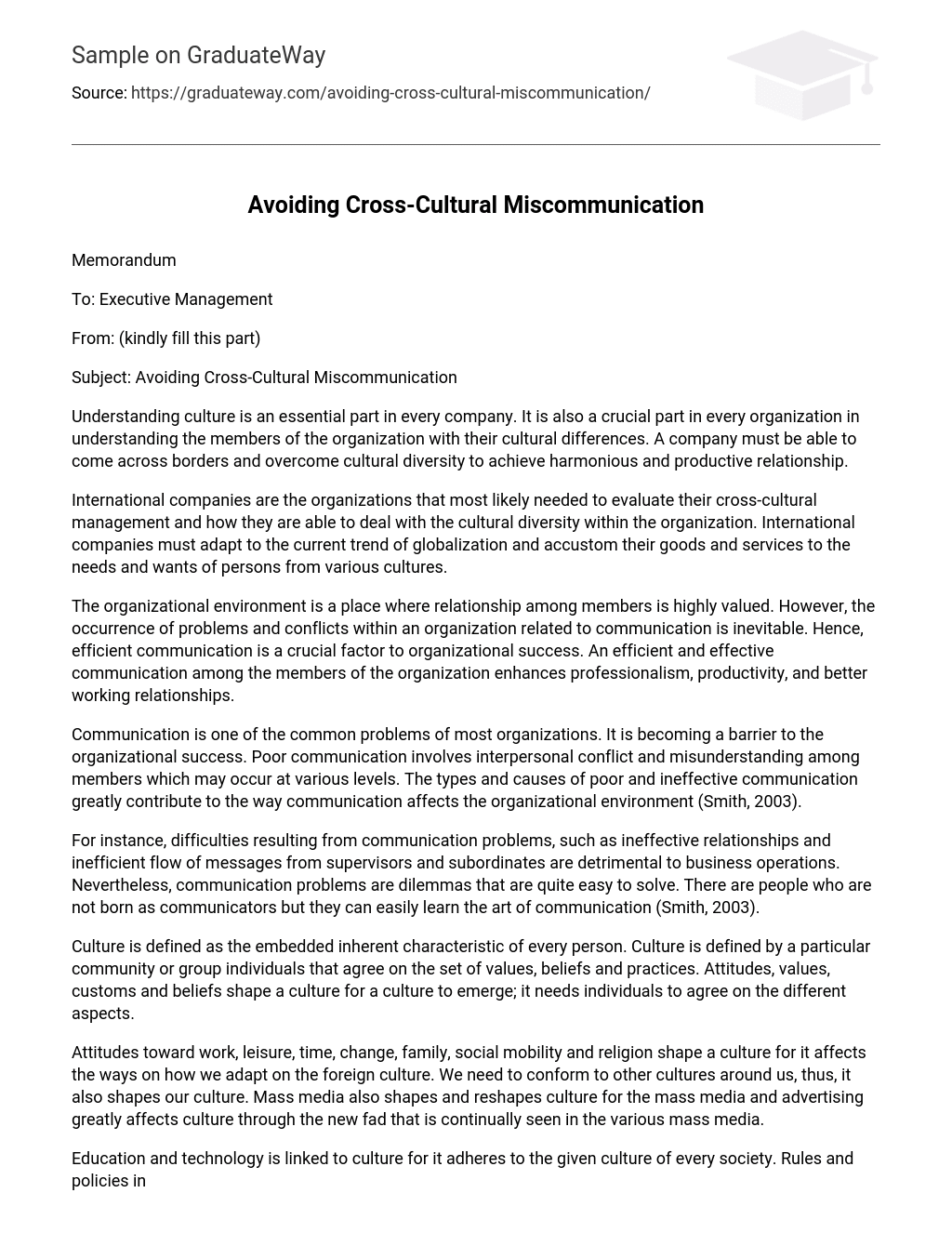Memorandum
To: Executive Management
From: (kindly fill this part)
Subject: Avoiding Cross-Cultural Miscommunication
Understanding culture is an essential part in every company. It is also a crucial part in every organization in understanding the members of the organization with their cultural differences. A company must be able to come across borders and overcome cultural diversity to achieve harmonious and productive relationship.
International companies are the organizations that most likely needed to evaluate their cross-cultural management and how they are able to deal with the cultural diversity within the organization. International companies must adapt to the current trend of globalization and accustom their goods and services to the needs and wants of persons from various cultures.
The organizational environment is a place where relationship among members is highly valued. However, the occurrence of problems and conflicts within an organization related to communication is inevitable. Hence, efficient communication is a crucial factor to organizational success. An efficient and effective communication among the members of the organization enhances professionalism, productivity, and better working relationships.
Communication is one of the common problems of most organizations. It is becoming a barrier to the organizational success. Poor communication involves interpersonal conflict and misunderstanding among members which may occur at various levels. The types and causes of poor and ineffective communication greatly contribute to the way communication affects the organizational environment (Smith, 2003).
For instance, difficulties resulting from communication problems, such as ineffective relationships and inefficient flow of messages from supervisors and subordinates are detrimental to business operations. Nevertheless, communication problems are dilemmas that are quite easy to solve. There are people who are not born as communicators but they can easily learn the art of communication (Smith, 2003).
Culture is defined as the embedded inherent characteristic of every person. Culture is defined by a particular community or group individuals that agree on the set of values, beliefs and practices. Attitudes, values, customs and beliefs shape a culture for a culture to emerge; it needs individuals to agree on the different aspects.
Attitudes toward work, leisure, time, change, family, social mobility and religion shape a culture for it affects the ways on how we adapt on the foreign culture. We need to conform to other cultures around us, thus, it also shapes our culture. Mass media also shapes and reshapes culture for the mass media and advertising greatly affects culture through the new fad that is continually seen in the various mass media.
Education and technology is linked to culture for it adheres to the given culture of every society. Rules and policies in education and technology conform on the culture of a particular place. Laws of the land also conform on the culture of the particular place. It affects the companies for the variety of laws governing each territorial domain. They have to adapt their products and services on the laws of the land.
One of the problems that emerged from culture is ethnocentricity. Ethnocentricity refers to characteristics that a culture thinks superior (“Ethnocentric”, 2008). Some cultures tend to think that their own culture dominates others. Racism and discrimination are socio-political factors that emerged from ethnocentricity. It is important that companies overcome ethnocentricity to be able to achieve unity and productive relationship of their employees.
There are various ways for a company to adapt on the local culture of a community. Communication plays significant roles in the organization for it renders outcomes and predicts the behavior of the members. Communication functions and organizing cannot be separated. These two are the principal ingredient of organizational success (King, 1989).
Organizations must also understand the various aspects of a culture and immerse themselves to fully observe the inherent culture. Immersion can be an effective strategy in adapting to a local culture and acquiring experiences that are unique on that culture.
Culture is composed of various elements and companies need to be aware of such elements to be able to operate profitably and successfully. Some of these elements are religion and customs. Religion is one of the concepts that are difficult to define but most influential. It is perceived as “theological, philosophical, anthropological, sociological, and psychological phenomenon of human kind.” (Robinson, 2007). Customs, on the other hand, is also one of the most influential aspects of every culture. It is a practice that is followed by group of people in a particular place. It may also be perceived as an individual task, it can be a habitual practice of a person (“Customs”, 2008). These are crucial aspects of culture that is essential for the organizations to understand.
Communication also played a significant part in every culture. Verbal and non-verbal communications are important aspects of cultures for every culture may have different interpretation on what we say or do. Cultures may have high or low context communication that affects the way they communicate regarding business transactions. Global companies should know the different types of communication to be able to conduct business properly.
It is essential for companies to be aware of the various aspects of every culture for it affects the whole global business industry. If a company wants to go international, it must first achieve cultural acceptance and great understanding to relate effectively on their target consumers.
References
Customs. (2008). The Free Dictionary. Falex, Inc. Retrieved December 19, 2008 from http://www.thefreedictionary.com/customs
Ethnocentric. (2008). Merriam-Webster Online Dictionary.
Retrieved December 19, 2008, from
http://www.merriamwebster.com/dictionary/ethnocentric.
King, S.S. (1989). Human Communication as a Field of Study. Albany, New York: State University of New York.
Robinson, B.A. (2007, December 15). Definitions of the Word “Religion” (None are Totally Satisfying). ReligiousTolerence.org. Retrieved December 19, 2008 from http://www.religioustolerance.org/rel_defn.htm.
Smith, S. (2003). Remove your Workplace Communication Barriers: They are Costing more than you Think!. Next Level Consulting. Retrieved October 29, 2008 from http://www.nextlevel-consulting.com/articles/management/article06.html.





